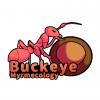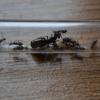Camponotus castaneus Colony B
A lot of the brood has been developing, but most of it is still in L2. However, some of the brood is likely going to pupate within the next few days. Last night, I also gave them some sugar water, and they had an absolute feast! They also finally fed the queen, and I suspect she should start to lay within the next few weeks.
Camponotus castaneus Colony C
Unlike what happened in Colony B, only one worker was accepted into the colony, and that was the major. The opposite was true in Colony B, where the major, who seemed to already be on the way out, ended up dying and being torn apart. All of the unaccepted workers have died in the outworld, and one worker escaped and got captured by the cellar side who lives at the foot of my bed. After such a large meal, she seems to be a lot larger and happier.
Solenopsis invicta Queens
The oldest of these queens has still yet to produce anything, and I suspect she is infertile. All of the other queens (except for the one I collected Friday night) have laid eggs, and have around 20 or so eggs.
Crematogaster cf. ashmeadi/lineolata Queens
Over half of these queens have laid eggs, though most of them have only laid a few eggs, like five or so. Some of the queens also have greatly engorged gasters, so more eggs are on the way.
Pheidole navigans
So though she has laid eggs, she keeps spreading them all over the place as opposed to keeping them all together, which results in the eggs dying. Because of this, it is likely she is infertile.
Lasius claviger Queens
One of the Lasius queens has ended up dying, but in spite of that, I managed to collect another queen, though she may actually be a different species, as she looks a little different. She may be a hybrid, or perhaps Lasius latipes. I tried to run her through a key, but she would not sit still, so I'll have to wait until workers arrive (or more likely until she dies...).





















